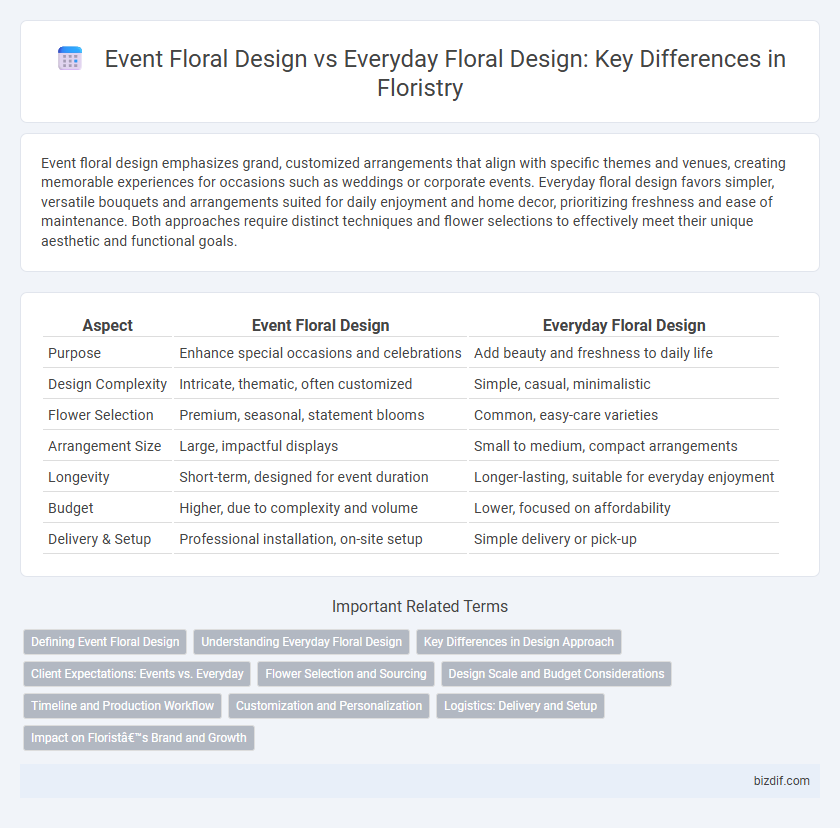Event floral design emphasizes grand, customized arrangements that align with specific themes and venues, creating memorable experiences for occasions such as weddings or corporate events. Everyday floral design favors simpler, versatile bouquets and arrangements suited for daily enjoyment and home decor, prioritizing freshness and ease of maintenance. Both approaches require distinct techniques and flower selections to effectively meet their unique aesthetic and functional goals.
Table of Comparison
| Aspect | Event Floral Design | Everyday Floral Design |
|---|---|---|
| Purpose | Enhance special occasions and celebrations | Add beauty and freshness to daily life |
| Design Complexity | Intricate, thematic, often customized | Simple, casual, minimalistic |
| Flower Selection | Premium, seasonal, statement blooms | Common, easy-care varieties |
| Arrangement Size | Large, impactful displays | Small to medium, compact arrangements |
| Longevity | Short-term, designed for event duration | Longer-lasting, suitable for everyday enjoyment |
| Budget | Higher, due to complexity and volume | Lower, focused on affordability |
| Delivery & Setup | Professional installation, on-site setup | Simple delivery or pick-up |
Defining Event Floral Design
Event floral design focuses on creating customized, thematic arrangements that enhance the ambiance of weddings, corporate gatherings, and special celebrations. These designs often incorporate seasonal blooms, color palettes, and structural elements tailored to the event's style and scale. Unlike everyday floral design, event floristry emphasizes intricate centerpieces, large installations, and cohesive decor coordination to make a memorable visual impact.
Understanding Everyday Floral Design
Everyday floral design emphasizes simplicity, functionality, and long-lasting freshness, using seasonal blooms and greenery that complement daily living spaces without overwhelming them. Unlike event floral design, which often features elaborate arrangements tailored to specific themes or occasions, everyday designs prioritize ease of maintenance and subtle aesthetic appeal. Incorporating popular flowers like roses, carnations, and chrysanthemums ensures durability and affordability while enhancing home or office environments with natural beauty.
Key Differences in Design Approach
Event floral design emphasizes grand, thematic arrangements tailored to specific occasions, incorporating elaborate structures and seasonal blooms to create visual impact. Everyday floral design prioritizes simplicity, durability, and versatility, using smaller, low-maintenance bouquets suited for daily environments such as homes or offices. The choice of flowers, color palettes, and arrangement styles diverge significantly, reflecting the functional and aesthetic demands unique to each floral context.
Client Expectations: Events vs. Everyday
Event floral design demands intricate, bespoke arrangements that align closely with the client's theme, color palette, and desired atmosphere, requiring high customization and durability for specific dates and venues. Everyday floral design prioritizes simplicity, freshness, and versatility, catering to routine enjoyment with seasonal blooms and straightforward arrangements that suit a broader range of preferences. Clients expect event florals to make a bold, memorable impact, whereas everyday floral buyers seek affordable elegance and ease of maintenance.
Flower Selection and Sourcing
Event floral design demands carefully curated, seasonal blooms sourced from specialized growers or wholesalers to ensure freshness and visual impact. Everyday floral design emphasizes locally available, durable flowers like chrysanthemums and alstroemeria, which maintain longevity and affordability. Both approaches prioritize flower quality, but event design often incorporates rare or exotic varieties to elevate aesthetics.
Design Scale and Budget Considerations
Event floral design typically involves large-scale arrangements requiring extensive materials and higher budgets to create impactful visuals for ceremonies or celebrations. Everyday floral design emphasizes smaller, more budget-friendly compositions suitable for casual environments like homes or offices, focusing on simplicity and seasonal blooms. Budget allocation in event floristry prioritizes statement pieces and customization, while everyday designs balance cost-effectiveness with aesthetic appeal.
Timeline and Production Workflow
Event floral design requires meticulous planning with a production timeline often spanning weeks to coordinate sourcing, custom arrangements, and delivery for specific dates. Everyday floral design involves a streamlined workflow focusing on quick turnover, typically completed within hours or a day to accommodate fresh, seasonal selections. Efficient inventory management and just-in-time procurement are critical in balancing creativity and operational demands in both timelines.
Customization and Personalization
Event floral design emphasizes high levels of customization and personalization to match the specific theme, color scheme, and mood of weddings, corporate functions, or special celebrations. Everyday floral design tends to focus on seasonal availability and general aesthetic appeal, offering versatile arrangements suitable for home or office decor. Custom event florals often involve bespoke elements such as monograms, unique flower varieties, and tailored vase selections to create a distinctive atmosphere.
Logistics: Delivery and Setup
Event floral design requires precise logistics coordination including scheduled delivery times and on-site setup to ensure flowers remain fresh and arrangements intact for specific occasions like weddings or corporate events. Everyday floral design logistics emphasize flexible delivery schedules, often utilizing standardized packaging for quick handling and easy setup in retail or residential settings. Efficient transportation methods and temperature-controlled vehicles are essential for both to preserve flower quality during transit.
Impact on Florist’s Brand and Growth
Event floral design enhances a florist's brand by showcasing creativity and catering to large-scale, customized projects that attract high-profile clients and generate substantial revenue. Everyday floral design builds consistent customer relationships through regular sales and brand visibility in local markets, fostering steady growth and community trust. Balancing both design types diversifies income streams and strengthens a florist's reputation across different customer segments.
Event floral design vs everyday floral design Infographic

 bizdif.com
bizdif.com